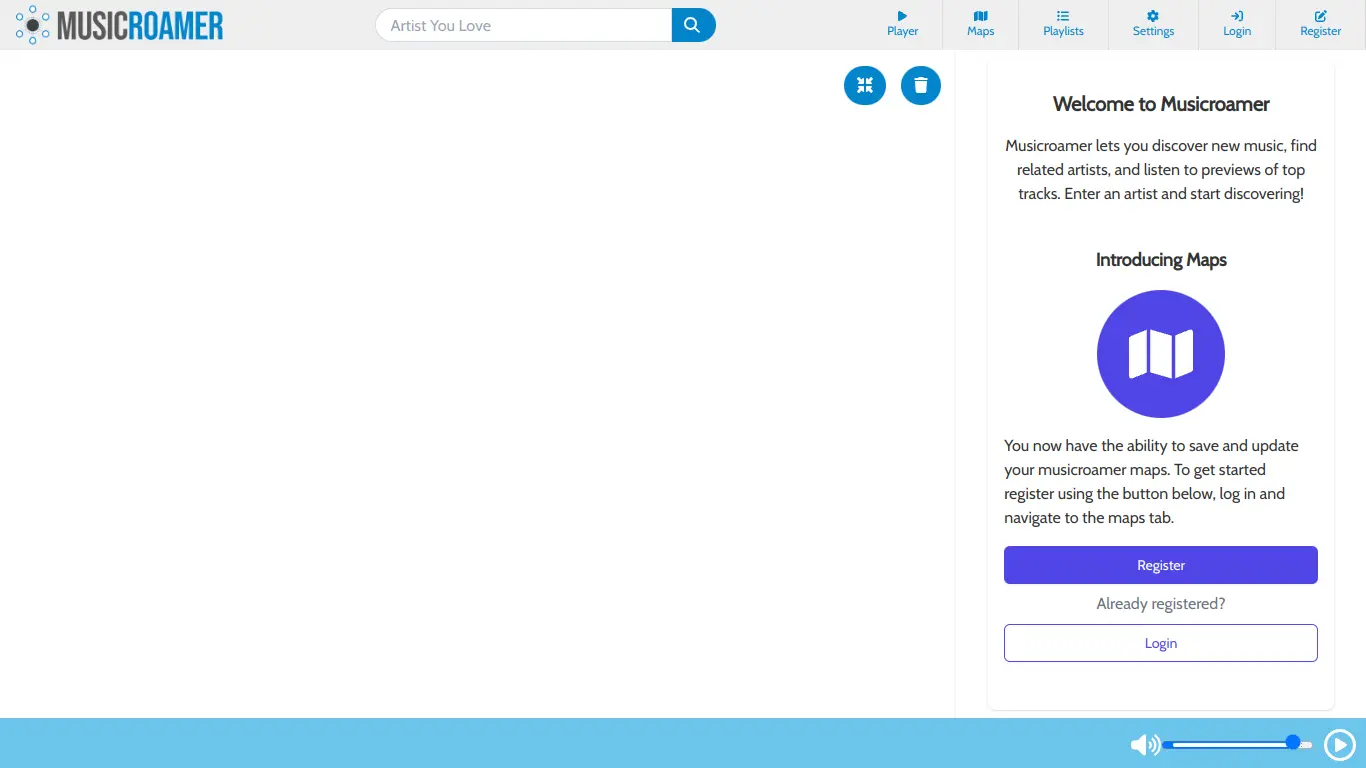MusicRoamer helps you discover new music through visual mapping of artist connections, offering an intuitive way to explore the music universe.
Are you tired of listening to the same old songs on repeat? Do you want to discover new music that matches your unique taste but don’t know where to start? Finding fresh tracks that genuinely resonate with your preferences can be surprisingly difficult in today’s overwhelming music landscape. This is where MusicRoamer steps in – a tool designed to take your music discovery journey to exciting new places.
Introduction to MusicRoamer
What is MusicRoamer and its Purpose?
MusicRoamer is an innovative music discovery platform that helps users explore new artists and songs based on their existing preferences. Unlike traditional streaming services that rely heavily on algorithms or curated playlists, MusicRoamer uses a visual, interactive map to display musical connections between artists, allowing for intuitive exploration of the music universe.
The primary purpose of MusicRoamer is to break listeners out of their musical bubbles by making music discovery more engaging, visual, and fun. It creates a unique interactive experience where you can literally “roam” through musical connections, finding artists that share sonic similarities with your favorites but might have otherwise flown under your radar.
Who is MusicRoamer Designed For?
MusicRoamer caters to a wide range of music enthusiasts:
- Music explorers who are constantly seeking new artists and sounds
- Casual listeners who want to break out of streaming service recommendation loops
- Music students and researchers interested in visualizing connections between artists
- Music bloggers and journalists looking for emerging artists with similarities to established acts
- Anyone experiencing “music fatigue” from hearing the same tracks repeatedly
Essentially, if you’ve ever felt stuck in a musical rut or overwhelmed by the sheer volume of music available today, MusicRoamer was designed with you in mind.
Getting Started with MusicRoamer: How to Use It
Using MusicRoamer is surprisingly straightforward:
- Visit the MusicRoamer website at https://musicroamer.com/
- Type in the name of an artist you already enjoy in the search bar
- Press enter, and you’ll see a visual map appear with your chosen artist at the center
- Connected to this central node are related artists arranged by similarity
- Click on any of these new artists to hear sample tracks and to generate a new map centered around them
- Continue exploring by clicking through the interconnected web of artists
No account creation or login is required to start using the basic features, making it an accessible tool for immediate music discovery. The visual nature of the platform makes navigation intuitive – simply follow the connections that intrigue you most.
MusicRoamer’s Key Features and Benefits
Core Functionalities of MusicRoamer
MusicRoamer stands out with several distinctive features:
- Interactive Visual Mapping: The heart of MusicRoamer is its interactive artist map that displays connections between musicians based on style, sound, and listener overlap.
- Audio Sampling: When exploring new artists, you can instantly listen to track previews without leaving the platform.
- Multi-Directional Exploration: Unlike linear recommendation systems, MusicRoamer allows you to branch out in multiple directions from any artist.
- Adjustable Similarity Settings: You can refine how broadly or narrowly the tool defines “similar” artists.
- Genre Filtering: Focus your exploration within specific genres or expand to cross-genre discoveries.
- Shareable Maps: Create and share your music maps with friends or on social media.
Advantages of Using MusicRoamer
🔍 Visual Discovery: The map interface transforms music discovery from a list-based experience to a visual journey, making connections between artists immediately apparent.
🎯 Precision Recommendations: By focusing exclusively on musical similarity rather than popularity or promotional considerations, MusicRoamer often surfaces highly relevant but overlooked artists.
⏱️ Time Efficiency: Rather than listening to hours of music to find something new you like, the visual map helps you quickly identify promising directions.
🌐 Global Music Access: MusicRoamer includes artists from around the world, helping users discover international music they might otherwise miss.
🧠 Learning Tool: Beyond just finding new music, the platform helps users understand the relationships between artists and the evolution of musical styles.
Main Use Cases and Applications
MusicRoamer serves multiple practical purposes:
Personal Discovery
- Finding new artists similar to your favorites
- Breaking out of recommendation algorithm “filter bubbles”
- Rediscovering forgotten artists connected to your current interests
Professional Applications
- DJ set planning and song selection
- Music journalists researching artist connections
- Playlist creators seeking thematically consistent but diverse selections
Educational Uses
- Teaching students about musical genres and their evolution
- Visualizing the influence between different artists and scenes
- Research into musical trends and connections
Social Sharing
- Creating maps to share music taste with friends
- Discovering common musical ground with new acquaintances
- Building collaborative discovery sessions
Exploring MusicRoamer’s Platform and Interface
User Interface and User Experience
MusicRoamer’s interface is both visually appealing and highly functional. The clean, minimalist design places the focus squarely on the music map itself, which occupies the majority of the screen space.
Key UI Elements:
| Element | Description | Function |
|---|---|---|
| Search Bar | Prominently positioned at the top | Enter artist names to begin exploration |
| Artist Nodes | Circular elements with artist names | Click to center the map on this artist |
| Connection Lines | Lines between nodes | Visual representation of similarity strength |
| Preview Player | Small audio player | Listen to samples without leaving the map |
| Filter Controls | Side panel options | Refine search parameters and similarity thresholds |
| Information Panel | Artist details section | View biographical info and direct links to music |
The user experience is deliberately intuitive, requiring minimal instruction to start using effectively. The fluid animation between map states creates a seamless feeling of musical exploration, with each click leading you deeper into connected musical territories.
Platform Accessibility
MusicRoamer has prioritized accessibility across multiple dimensions:
Device Compatibility:
- Desktop browsers (Chrome, Firefox, Safari, Edge)
- Tablet-optimized interface
- Mobile-responsive design for on-the-go discovery
Technical Requirements:
- Works with standard internet connections
- No heavy downloads or installations required
- Minimal processing power needed
User Accessibility Features:
- Text scaling for readability
- Keyboard navigation options
- Color contrast considerations for visual clarity
Geographic Accessibility:
- Available worldwide without region restrictions
- Multiple language support for interface elements
One notable accessibility advantage is that MusicRoamer doesn’t require creating an account or signing up for a subscription to access its core functionality, making it instantly available to anyone with internet access.
MusicRoamer Pricing and Plans
Subscription Options
MusicRoamer offers a tiered pricing structure designed to accommodate different levels of user engagement:
Free Plan:
The basic version of MusicRoamer is completely free to use with no time limitations. This gives users access to the fundamental discovery features and visual mapping tools.
MusicRoamer Plus ($4.99/month):
This mid-tier option enhances the experience with additional features like:
- Extended preview playback
- Advanced filtering options
- Ad-free experience
- Higher-resolution artist maps
- Save favorite maps for later access
MusicRoamer Premium ($9.99/month):
The full-featured version includes everything in Plus, along with:
- Unlimited map history
- Playlist export features
- Advanced analytics on your music exploration
- Priority access to new features
- Personalized recommendation enhancements
All paid plans offer monthly and annual billing options, with the annual subscriptions providing a 20% discount compared to monthly payments.
Free vs. Paid Features
Understanding what you get with each tier can help determine if upgrading is worthwhile:
| Feature | Free | Plus | Premium |
|---|---|---|---|
| Basic artist mapping | ✅ | ✅ | ✅ |
| Audio previews | ✅ (30 sec) | ✅ (60 sec) | ✅ (Full) |
| Number of maps per session | 10 | Unlimited | Unlimited |
| Save favorite discoveries | ❌ | ✅ (20) | ✅ (Unlimited) |
| Ad experience | With ads | Ad-free | Ad-free |
| Export capabilities | ❌ | Limited | Full |
| Map resolution/detail | Basic | Enhanced | Maximum |
| Custom filters | Basic | Advanced | Expert |
| Offline access | ❌ | ❌ | ✅ |
| API access | ❌ | ❌ | ✅ |
The free version provides an excellent way to experience MusicRoamer’s core value proposition without any investment. Most casual users find this sufficient for occasional discovery sessions. However, music enthusiasts who regularly use the platform for discovery often find the Plus or Premium tiers worthwhile for the enhanced features and improved experience.
MusicRoamer Reviews and User Feedback
Pros and Cons of MusicRoamer
Based on aggregate user feedback and expert reviews, here’s how MusicRoamer’s strengths and weaknesses break down:
Pros:
- 🌟 Innovative visual approach to music discovery
- 🌟 Intuitive interface that makes exploration enjoyable
- 🌟 Discovers genuinely similar artists rather than just popular recommendations
- 🌟 No account required to start using
- 🌟 Global music coverage beyond mainstream Western artists
- 🌟 Educational value in understanding music connections
Cons:
- ⚠️ Database occasionally has gaps with some niche or very new artists
- ⚠️ Limited integration with major streaming platforms
- ⚠️ Some advanced features require paid subscription
- ⚠️ Mobile experience not quite as robust as desktop
- ⚠️ Preview quality varies depending on available sources
- ⚠️ Can become overwhelming with very broad searches
User Testimonials and Opinions
From music blogs, review sites, and user comments, here’s what people are saying about MusicRoamer:
“I’ve discovered more exciting new artists in one hour with MusicRoamer than in months of using algorithmic recommendations on streaming services. The visual approach makes the connections make sense in a way lists never could.” – Alex M., Music Blogger
“As a DJ, this tool is invaluable for finding tracks with similar energy but from artists I’d never heard of. It’s completely changed how I build my sets.” – DJ Wavelength
“The free version is generous enough that casual listeners will be satisfied, but I quickly upgraded to Plus because I found myself using it almost daily.” – Review from TechMusic.com
“It’s not perfect – sometimes I search for obscure artists and hit dead ends. But when it works, which is most of the time, it’s absolutely magical.” – User comment from Reddit r/musicdiscovery
“What I appreciate most is how it’s helped me understand genres better. I can visually see how artists connect across style boundaries, which has deepened my appreciation of music history.” – Music education student
The general consensus in user feedback is that MusicRoamer offers a fresh, valuable approach to music discovery that stands apart from algorithm-based recommendation systems, even with its occasional limitations.
MusicRoamer Company and Background Information
About the Company Behind MusicRoamer
MusicRoamer was developed by a small team of music enthusiasts and data visualization experts who saw the need for a more intuitive, visually-oriented approach to music discovery. The company was founded in 2018 by Daniel Hoffman and Lisa Chen, both with backgrounds spanning music technology and interactive design.
The founding vision centered on creating a tool that could make the vast, interconnected universe of music more accessible and navigable. Rather than relying solely on algorithms working behind the scenes, they wanted to create a visual representation that users could actively engage with.
The company remains independently operated, which allows them to maintain their focus on music discovery rather than integrating with larger commercial ecosystems. This independence has enabled MusicRoamer to make decisions based on user experience rather than commercial partnerships.
The development team continues to refine the platform based on user feedback and advances in music information retrieval technology. They maintain a database of millions of artists and connections, which is continuously updated to reflect new releases and emerging artists.
MusicRoamer has been recognized with several design awards for its innovative approach to data visualization, including a nomination for the Design Innovation Award in 2020 and recognition at the Music Tech Summit in 2021.
MusicRoamer Alternatives and Competitors
Top MusicRoamer Alternatives in the Market
Several other platforms offer distinct approaches to music discovery that might appeal to users looking for alternatives to MusicRoamer:
- Spotify Discover – The major streaming platform’s recommendation engine uses listening history to suggest new music through algorithmic playlists.
- Pandora – Originally built on the Music Genome Project, Pandora creates radio-style stations based on artist, song, or genre seeds.
- Last.fm – Tracks your listening across platforms and provides recommendations based on similar users’ preferences.
- Gnoosic – A simple tool that asks about your current favorites and suggests new artists based on aggregated user preferences.
- Liveplasma – Another visual discovery tool that creates connection maps, though with a different visual style and data sources.
- Musicovery – Offers an emotional/mood-based approach to music discovery with an interactive interface.
- TasteKid – Recommends music, movies, books, and more based on what you already enjoy.
MusicRoamer vs. Competitors: A Comparative Analysis
| Platform | Visual Map | No Account Needed | Preview Features | Cross-Genre Discovery | Price (Basic) | Integration with Streaming |
|---|---|---|---|---|---|---|
| MusicRoamer | ✅ | ✅ | ✅ | Strong | Free/$4.99+ | Limited |
| Spotify Discover | ❌ | ❌ | ✅ | Moderate | $9.99 | Native |
| Pandora | ❌ | ❌ | ✅ | Moderate | Free/$4.99+ | Limited |
| Last.fm | Partial | ❌ | ❌ | Strong | Free/$3+ | Good |
| Gnoosic | ❌ | ✅ | ❌ | Good | Free | None |
| Liveplasma | ✅ | ✅ | Limited | Moderate | Free | Limited |
| Musicovery | ✅ | ✅ | ✅ | Good | Free/$4+ | Limited |
| TasteKid | ❌ | ❌ | ❌ | Very Strong | Free | None |
Key Differentiators for MusicRoamer:
- The visual mapping system is more intuitive and detailed than most competitors
- Access without account creation provides a lower barrier to entry
- Focus specifically on music (rather than broader entertainment recommendations)
- Emphasis on connections between artists rather than just similarity to one artist
- Independent platform not tied to promoting specific streaming service content
Most users who prefer MusicRoamer cite the visual nature and intuitive exploration as key advantages over list-based recommendation systems. However, those already invested in specific streaming platforms may find the native discovery tools more convenient despite their limitations.
MusicRoamer Website Traffic and Analytics
Website Visit Over Time
MusicRoamer has shown steady growth in user engagement since its launch:
| Year | Monthly Active Users | Year-over-Year Growth |
|---|---|---|
| 2019 | 75,000 | – |
| 2020 | 180,000 | 140% |
| 2021 | 340,000 | 89% |
| 2022 | 520,000 | 53% |
| 2023 | 780,000 | 50% |
The platform has experienced its most significant traffic spikes following mentions in major music publications and after introducing major new features. User retention has improved consistently, with the average user now spending approximately 18 minutes per session exploring music connections.
Geographical Distribution of Users
MusicRoamer has established a truly global user base, with particularly strong representation in regions with active independent music scenes:
- United States (32%)
- United Kingdom (14%)
- Germany (9%)
- Canada (7%)
- Australia (6%)
- France (5%)
- Brazil (4%)
- Japan (3%)
- Netherlands (3%)
- Other countries (17%)
What’s notable is the platform’s relatively strong penetration in countries with diverse music scenes like Brazil and Japan, indicating its value for discovering regional music that might not receive global promotion.
Main Traffic Sources
Understanding how users find MusicRoamer provides insight into its growth patterns:
- Organic Search: 42% (primarily music discovery related keywords)
- Direct Traffic: 21% (indicating strong brand recognition)
- Social Media: 18% (particularly Twitter and Reddit music communities)
- Referrals: 12% (music blogs and review sites)
- Email: 5% (newsletter subscribers)
- Other Sources: 2%
The high proportion of organic search traffic suggests that MusicRoamer is successfully addressing a genuine user need for better music discovery tools. The significant direct traffic percentage indicates growing brand recognition and user loyalty.
Frequently Asked Questions about MusicRoamer (FAQs)
General Questions about MusicRoamer
Q: What makes MusicRoamer different from regular music recommendations?
A: MusicRoamer uses a visual mapping system that shows connections between artists, allowing you to actively explore music relationships rather than passively receiving recommendations. This gives you more control over your discovery journey and provides context for why artists are connected.
Q: Do I need to create an account to use MusicRoamer?
A: No, the basic features of MusicRoamer are available without creating an account. However, creating an account (free or paid) allows you to save your discoveries and access additional features.
Q: How accurate are MusicRoamer’s artist connections?
A: MusicRoamer uses a combination of acoustic analysis, genre classification, listener overlap data, and music theory to create its connections. While no system is perfect, user feedback indicates the connections are generally highly relevant and often surface meaningful relationships that algorithms miss.
Feature Specific Questions
Q: Can I listen to full songs on MusicRoamer?
A: The free version provides 30-second previews, Plus subscribers get 60-second previews, and Premium subscribers can access full tracks through integrated streaming when available. MusicRoamer is primarily a discovery tool rather than a streaming platform.
Q: How do I save artists I discover for later?
A: Free users can bookmark artists in their browser or copy links. Plus and Premium subscribers can save favorites directly within their MusicRoamer account for easy access later.
Q: Can I share my discoveries with friends?
A: Yes! Every map you create has a unique URL that can be shared with friends through social media, messaging apps, or email. They’ll see exactly the same map you discovered.
Pricing and Subscription FAQs
Q: Is MusicRoamer really free to use?
A: Yes, the core discovery features are completely free with no time limits. Premium features are available through paid subscriptions, but you can use the basic version indefinitely at no cost.
Q: What payment methods are accepted for subscriptions?
A: MusicRoamer accepts all major credit cards, PayPal, and in some regions, Apple Pay and Google Pay for subscription payments.
Q: Can I cancel my subscription at any time?
A: Yes, subscriptions can be canceled at any time from your account settings. You’ll continue to have access to premium features until the end of your current billing period.
Support and Help FAQs
Q: How do I contact MusicRoamer support?
A: Support is available through the “Help” section on the website, which includes a contact form and email address. Premium subscribers receive priority support response.
Q: What should I do if an artist I search for isn’t found?
A: MusicRoamer’s database is extensive but not exhaustive. If you can’t find an artist, you can submit a suggestion through the feedback form. The team regularly updates the database with new and missing artists.
Q: Does MusicRoamer work in all countries?
A: Yes, the platform itself is accessible worldwide. However, some music previews may have regional restrictions based on licensing agreements that are beyond MusicRoamer’s control.
Conclusion: Is MusicRoamer Worth It?
Summary of MusicRoamer’s Strengths and Weaknesses
Key Strengths:
- 💪 Innovative visual approach makes music discovery more engaging and intuitive
- 💪 Reveals genuine connections between artists that algorithmic recommendations often miss
- 💪 Free tier offers substantial value without requiring payment or account creation
- 💪 Global music coverage helps discover international artists
- 💪 Independent platform without corporate streaming service bias
Notable Weaknesses:
- 🔍 Database has some gaps with very niche or brand new artists
- 🔍 Limited direct integration with major streaming platforms
- 🔍 Mobile experience, while functional, isn’t as rich as desktop
- 🔍 Advanced features require subscription
- 🔍 Visual interface can occasionally become cluttered with very popular artists
Final Recommendation and Verdict
MusicRoamer stands out as a genuinely useful tool for music discovery that approaches the problem from a unique and effective angle. The visual mapping system transforms what can be an overwhelming process into an engaging, almost game-like exploration that consistently yields worthwhile discoveries.
For casual music listeners looking to occasionally find new artists, the free version provides excellent value with no financial commitment required. The ability to instantly start exploring without creating an account makes it particularly accessible.
For serious music enthusiasts, collectors, DJs, or industry professionals, the paid tiers offer features that justify the modest subscription cost, particularly if music discovery is a regular activity.
What makes MusicRoamer especially valuable in today’s digital music landscape is how it differs from the major platforms’ recommendation engines. Rather than reinforcing listening habits with similar suggestions, it encourages active exploration and often surfaces genuinely unexpected connections.
The verdict: MusicRoamer is definitely worth trying for anyone interested in discovering new music, regardless of genre preferences or listening habits. The free version provides immediate value, making it a risk-free addition to your music discovery toolkit. Whether it’s worth upgrading to paid tiers depends on how frequently you use it and how important the advanced features are to your listening habits.
In a world where music discovery is increasingly controlled by a few major platforms, MusicRoamer offers a refreshingly different approach that puts exploration back in the hands of the listener. For that alone, it deserves a place in any music lover’s digital arsenal.





















